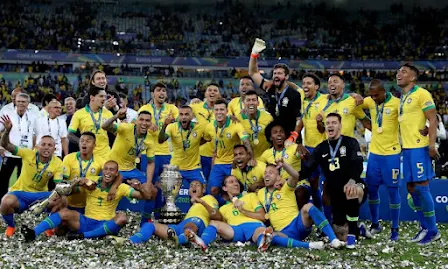Copa América: The Crown Jewel of South American Football
Football is more than just a game; it’s a cultural phenomenon, a religion in many parts of the world. In South America, the Copa América stands as the pinnacle of footballing passion, uniting nations in a fierce battle for continental supremacy. Organized by the South American Football Confederation (CONMEBOL), Copa América is the oldest international football tournament, dating back to 1916. It’s a tournament that not only showcases extraordinary talent but also brings vibrant traditions, heated rivalries, and unforgettable moments to the global stage.
In this blog post, we delve into the rich history, the tournament’s unique format, its most iconic moments, and the players who have left an indelible mark on this celebrated event.
The History of Copa América: A Legacy of Passion and Pride
The inaugural Copa América was held in Argentina in 1916 to commemorate the centenary of the nation’s independence. It featured just four teams: Argentina, Brazil, Chile, and Uruguay. Uruguay emerged victorious, sparking a footballing rivalry that has persisted for over a century.
Since then, Copa América has grown exponentially, both in scale and prestige. The tournament has expanded to include all ten CONMEBOL member nations: Argentina, Bolivia, Brazil, Chile, Colombia, Ecuador, Paraguay, Peru, Uruguay, and Venezuela. Occasionally, teams from other continents, such as Mexico, Japan, and Qatar, are invited to add more flair to the competition.
Tournament Format: A Showcase of Competitive Spirit
Copa América features a straightforward yet intense format. The tournament typically consists of a group stage followed by knockout rounds, culminating in a grand final. The competition’s structure ensures that every match is significant, with teams battling fiercely to secure a place in the next round.
- Group Stage: Teams are divided into groups, with each team playing the others in their group. The top teams advance to the knockout stages.
- Knockout Rounds: The quarter-finals, semi-finals, and final are single-elimination matches, where the stakes are incredibly high.
This format not only tests the teams’ tactical depth but also their mental resilience under pressure.
Iconic Moments in Copa América History
Over its century-long history, Copa América has produced countless iconic moments that remain etched in the memory of football fans.
-
Uruguay’s Dominance (1935-1956)
Uruguay established itself as the early powerhouse of South American football, winning multiple titles during this period. Their triumph in 1956, led by legendary forward Juan Alberto Schiaffino, cemented their legacy as Copa América royalty. -
Maradona’s Magic (1987)
While Diego Maradona is often celebrated for his World Cup heroics, his performance in the 1987 Copa América was equally mesmerizing. Despite Argentina’s semi-final loss to Uruguay, Maradona’s skill and vision illuminated the tournament.
-
Chile’s Back-to-Back Victories (2015, 2016)
Chile’s golden generation stunned the football world by winning consecutive Copa América titles, defeating Argentina in penalty shootouts on both occasions. These victories marked Chile’s first-ever major international trophies.
-
Brazil’s Comeback in 2019
Brazil’s 2019 triumph on home soil was a testament to their resilience and tactical prowess. After a disappointing World Cup in 2018, the Seleção, led by players like Dani Alves and Gabriel Jesus, reclaimed their position as South American champions.
Legendary Players of Copa América
Copa América has been graced by some of the greatest footballers to ever play the game.
- Pelé (Brazil): The “King of Football” won his first Copa América in 1959, where he was the top scorer and showcased his unparalleled talent.
- Lionel Messi (Argentina): After years of heartbreak, Messi finally lifted the Copa América trophy in 2021, solidifying his place among the tournament’s legends.
- Zico (Brazil): Renowned for his technical brilliance, Zico lit up Copa América in the 1980s with his goal-scoring prowess.
- Paolo Guerrero (Peru): One of the tournament’s top scorers, Guerrero has consistently delivered for Peru, earning a reputation as a clutch performer.
The Cultural Impact of Copa América
Copa América is more than just a football tournament; it’s a celebration of South American culture. From the rhythmic beats of samba and tango to the colorful jerseys and roaring crowds, every aspect of the tournament reflects the region’s rich cultural heritage.
The fierce rivalries, particularly between Argentina and Brazil, often transcend football, becoming a matter of national pride. Yet, Copa América also fosters a sense of unity, as fans from across the continent come together to celebrate their shared love for the beautiful game.
Looking Ahead: The Future of Copa América
With the next edition of Copa América scheduled to be held in 2024, the anticipation is already building. The tournament promises to deliver more thrilling matches, rising stars, and unforgettable moments. As football continues to evolve, Copa América remains a timeless reminder of the sport’s ability to inspire and unite.
Final Thoughts
Copa América is not just a competition; it’s a symbol of South America’s enduring love for football. It embodies the passion, skill, and resilience that define the region’s footballing identity. For fans around the world, it’s an opportunity to witness the magic of the sport at its finest.
At Sports Head Coach, we celebrate the essence of such iconic tournaments. Stay tuned for more in-depth analysis, expert insights, and exclusive coverage of the world’s most captivating sporting events.
Ready to explore more about the world of sports? Visit our blog for the latest updates and expert takes!









This content is for you, enjoy it.
ReplyDelete